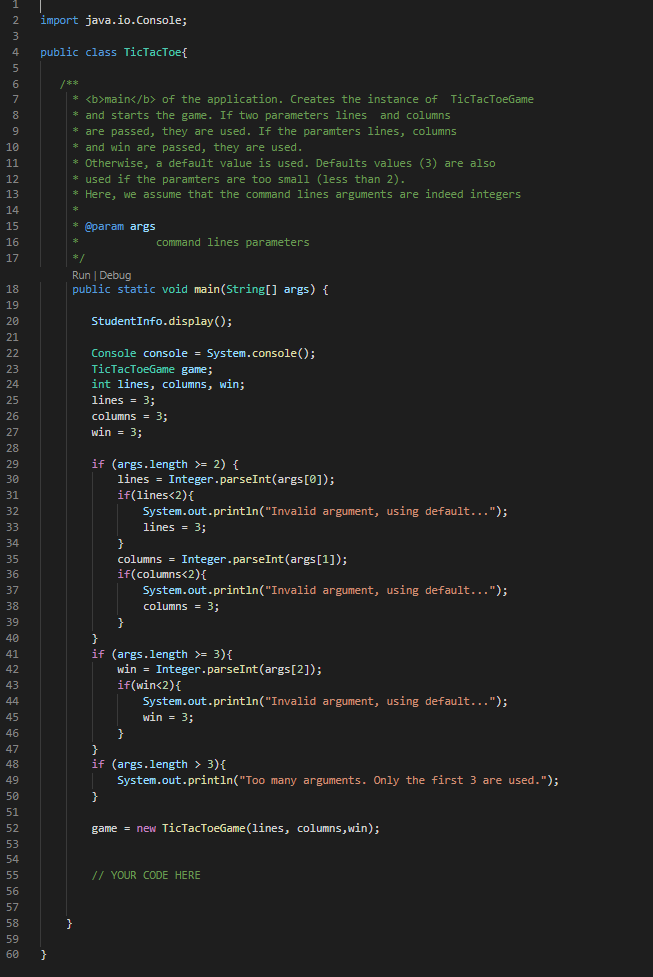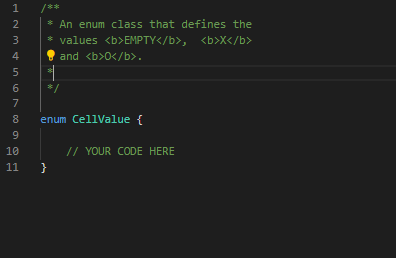Question
Create a TicTacToe game in Java using these template codes (TicTacToeGame.java, TicTacToe.java, CellValue.java, GameState.java): Do not modify the code provided. TicTacToeGame.java /** * The class
Create a TicTacToe game in Java using these template codes (TicTacToeGame.java, TicTacToe.java, CellValue.java, GameState.java): Do not modify the code provided. TicTacToeGame.java
/**
* The class TicTacToeGame is the
* class that implements the Tic Tac Toe Game.
* It contains the grid and tracks its progress.
* It automatically maintain the current state of
* the game as players are making moves.
*/
public class TicTacToeGame {
// FINISH THE VARIABLE DECLARATION
/**
* The board of the game, stored as a one dimension array.
*/
static String[] board;
/**
* level records the number of rounds that have been
* played so far.
*/
int level;
/**
* gameState records the current state of the game.
*/
int gameState;
/**
* lines is the number of lines in the grid
*/
int lines;
/**
* columns is the number of columns in the grid
*/
int columns;
/**
* sizeWin is the number of cell of the same type
* that must be aligned to win the game
*/
int sizeWin;
/**
* default constructor, for a game of 3x3, which must
* align 3 cells
*/
public TicTacToeGame(){
// YOUR CODE HERE
}
/**
* constructor allowing to specify the number of lines
* and the number of columns for the game. 3 cells must
* be aligned.
* @param lines
* the number of lines in the game
* @param columns
* the number of columns in the game
*/
public TicTacToeGame(int lines, int columns){
// YOUR CODE HERE
}
/**
* constructor allowing to specify the number of lines
* and the number of columns for the game, as well as
* the number of cells that must be aligned to win.
* @param lines
* the number of lines in the game
* @param columns
* the number of columns in the game
* @param sizeWin
* the number of cells that must be aligned to win.
*/
public TicTacToeGame(int lines, int columns, int sizeWin){
// YOUR CODE HERE
}
/**
* getter for the variable lines
* @return
* the value of lines
*/
public int getLines(){
// YOUR CODE HERE
return;
}
/**
* getter for the variable columns
* @return
* the value of columns
*/
public int getColumns(){
// YOUR CODE HERE
return;
}
/**
* getter for the variable level
* @return
* the value of level
*/
public int getLevel(){
// YOUR CODE HERE
return;
}
/**
* getter for the variable sizeWin
* @return
* the value of sizeWin
*/
public int getSizeWin(){
// YOUR CODE HERE
return;
}
/**
* getter for the variable gameState
* @return
* the value of gameState
*/
public GameState getGameState(){
// YOUR CODE HERE
return;
}
/**
* returns the cellValue that is expected next,
* in other word, which played (X or O) should
* play next.
* This method does not modify the state of the
* game.
* @return
* the value of the enum CellValue corresponding
* to the next expected value.
*/
public CellValue nextCellValue(){
// YOUR CODE HERE
return;
}
/**
* returns the value of the cell at
* index i.
* If the index is invalid, an error message is
* printed out. The behaviour is then unspecified
* @param i
* the index of the cell in the array board
* @return
* the value at index i in the variable board.
*/
public CellValue valueAt(int i) {
// YOUR CODE HERE
return;
}
/**
* This method is called when the next move has been
* decided by the next player. It receives the index
* of the cell to play as parameter.
* If the index is invalid, an error message is
* printed out. The behaviour is then unspecified
* If the chosen cell is not empty, an error message is
* printed out. The behaviour is then unspecified
* If the move is valide, the board is updated, as well
* as the state of the game.
* To faciliate testing, is is acceptable to keep playing
* after a game is already won. If that is the case, the
* a message should be printed out and the move recorded.
* the winner of the game is the player who won first
* @param i
* the index of the cell in the array board that has been
* selected by the next player
*/
public void play(int i) {
// YOUR CODE HERE
}
/**
* A helper method which updates the gameState variable
* correctly after the cell at index i was just set in
* the method play(int i)
* The method assumes that prior to setting the cell
* at index i, the gameState variable was correctly set.
* it also assumes that it is only called if the game was
* not already finished when the cell at index i was played
* (i.e. the game was playing). Therefore, it only needs to
* check if playing at index i has concluded the game, and if
* set the oucome correctly
*
* @param i
* the index of the cell in the array board that has just
* been set
*/
private void setGameState(int i){
// YOUR CODE HERE
}
/**
* Returns a String representation of the game matching
* the example provided in the assignment's description
*
* @return
* String representation of the game
*/
public String toString(){
// YOUR CODE HERE
}
}
TicTacToe.java

CellValue.java

GameState.java

Step by Step Solution
There are 3 Steps involved in it
Step: 1

Get Instant Access to Expert-Tailored Solutions
See step-by-step solutions with expert insights and AI powered tools for academic success
Step: 2

Step: 3

Ace Your Homework with AI
Get the answers you need in no time with our AI-driven, step-by-step assistance
Get Started


